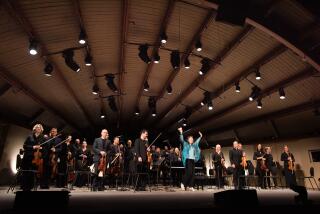MUSIC REVIEW : Welcome Return for The English Concert
- Share via
A palpable and genuine excitement seemed to fill Ambassador Auditorium Tuesday night for a return visit by The English Concert, Trevor Pinnock’s 15-year-old period-instrument ensemble. And no letdown took place through the length of a generous but balanced Haydn/Mozart/C. P. E. Bach program led by Pinnock from the harpsichord.
What happened between this 19-member body of instrumentalists and its large, hard-listening audience appeared to be an exchange of enthusiasms. It involved real interaction between affectionate, cogent delivery and delighted receipt of an agenda encompassing Haydn’s Symphonies Nos. 49 and 59, Mozart’s G-major Violin Concerto and a quirky but irresistible harpsichord concerto by J. S. Bach’s second son.
If the loudly approving members of that audience seemed also to be congratulating themselves for being present, so be it. That they were rewarded with stylish and probing performances, unobtrusively presided over by Pinnock--conducting has nothing to do with his function as leader here--only confirmed their good taste.
Pinnock’s inventive matching of these four works--all written within the nine-year period between 1766 and 1775--created a context in which all shone. The melancholy in Haydn’s F-minor (“La Passione”) and the ebullience of his A-major (“Fire”) symphonies emerged clear-cut, human characteristics specifically felt and expressed, not just the occasion of clean but abstract instrumentalism, dutifully manipulated.
The orchestral parts to the two concertos showed the same care and musical detailing. There were no accompanists here--soloists and ensemble operated as a unit, in single-minded gesture and motion. The results proved consistently delightful.
Simon Standage’s pristine, small-scale reading of Mozart’s Third Violin Concerto restored that much-abused showpiece to its original condition as a happy, chatty and thoughtful dialogue between friends. And Pinnock’s virtuosic romp through C. P. E. Bach’s Harpsichord Concerto in G, a witty work of many facets, made one wonder what other treasures may lie unrevived in his oeuvre .
More to Read
The biggest entertainment stories
Get our big stories about Hollywood, film, television, music, arts, culture and more right in your inbox as soon as they publish.
You may occasionally receive promotional content from the Los Angeles Times.










